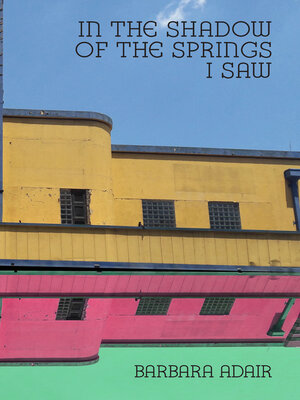
Sign up to save your library
With an OverDrive account, you can save your favorite libraries for at-a-glance information about availability. Find out more about OverDrive accounts.
Find this title in Libby, the library reading app by OverDrive.



Search for a digital library with this title
Title found at these libraries:
| Library Name | Distance |
|---|---|
| Loading... |
In the Shadow of the Springs I Saw is an exploration, and stories, of people who live in the Art Deco buildings of Springs. It is the imagined lives of those who live in a space that is not theirs historically but one that they have reclaimed. This work, in times of doom and complaint, creates a new narrative: one of revival, vigour and celebration. The writing tries to capture the grain of a place, object or conversation, as if a swatch were cut from a larger fabric. One could trace the use of similar techniques back to the canonical modernist works of James Joyce, William Faulkner, John Dos Passos, William Carlos Williams or to a later experimenter like Burroughs � Adair uses these techniques with flair and purpose � the book�s method is to declare and contradict, to present one side and then another, keeping both present.� Ivan Vladislavic Barbara Adair is a novelist and writer. In Tangier we Killed the Blue Parrot was shortlisted for the South African Sunday Times Fiction Award in 2004. Her novel End was shortlisted for Africa Regional Commonwealth Prize.|In the Shadow of the Springs I Saw is an exploration, and stories, of
people who live in the Art Deco buildings of Springs. It is the imagined
lives of those who live in a space that is not theirs historically but
one that they have reclaimed. This work, in times of doom and complaint,
creates a new narrative: one of revival, vigour and celebration.
'The writing tries to capture the "grain" of a place, object or conversation, as if a swatch were cut from a larger fabric. One could trace the use of similar techniques back to the canonical modernist works of James Joyce, William Faulkner, John Dos Passos, William Carlos Williams or to a later experimenter like Burroughs ... Adair uses these techniques with flair and purpose ... the book's method is to declare and contradict, to present one side and then another, keeping both present.' Ivan Vladislavic
'The writing tries to capture the "grain" of a place, object or conversation, as if a swatch were cut from a larger fabric. One could trace the use of similar techniques back to the canonical modernist works of James Joyce, William Faulkner, John Dos Passos, William Carlos Williams or to a later experimenter like Burroughs ... Adair uses these techniques with flair and purpose ... the book's method is to declare and contradict, to present one side and then another, keeping both present.' Ivan Vladislavic







